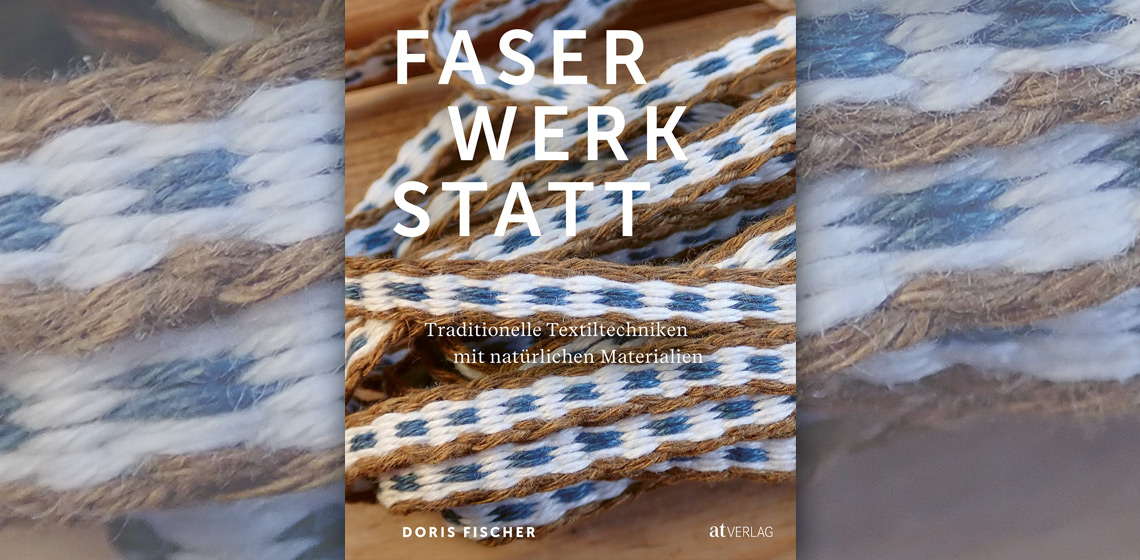The content is published under a Creative Commons Attribution Non-Commercial 4.0 License.
Unreviewed Mixed Matters Article:
Book Review: Faserwerkstatt by Doris Fischer

As the title implies, Faser Werkstatt: Traditionelle Textiltechnik mit natürlichen Materialien is a direct and practical book on the historical creation and use of fibers. It is aimed at a casual reader with little to no knowledge or experience with the fiber arts, with detailed instructions on creating and using threads and ropes made from natural fibers.
Faser Werkstatt is a how-to book, not an academic essay or analysis. However, it does include a good amount of background information and references pertinent to this area of research and examples of historical use.
The book does a good job of putting these practices into context, and tries to remind the reader that these techniques are not completely outdated and lost, showcasing use of traditional methods throughout the 1960s through photos and other images. An example is provided in the section on diagonal weaving, where Swiss traditional clothing is still being produced today, showing the reader that these old methods are still applied today.
The author purposely does not delve deep into regions or eras where the techniques were used for the most part. Many of the techniques, especially those for turning raw material into usable thread, appeared at many places across the globe. Weaving techniques were also used by many cultures in different time frames, and trying to find one single origin can be unfair or impossible. Where a method is unique to a culture or timeframe, the author highlights this, often giving specific examples that can easily be further researched by the reader afterwards.
The author leverages experts at living history museums for the step-by-step instructions that make this book a great option for hobbyists looking to cover multiple techniques in one volume. The benefit is having a variety of options with clear explanations, often with multiple photos. The author credits each expert by name and location.
While much of this information is available in many places, the author does a good job of giving us a clear line of fiber going from source to thread to end product, whether that is cord or a wearable object.
The book has four main sections: threads and fibers, bands and braids, clothing and accessories, and a wood workshop. The inclusion of the workshop means that a lay person can create their own tools if necessary, including bobbins, clappers, weaving tablets, and nalbinding tools.
The fibers covered focus on linden bast, linen, and stinging nettle. The author sees nettle as the most available plant to access, which leads to a focus on that plant. Hemp is mentioned and given its due importance, however, this does not get its own step-by-step treatment highlight. This is an unfortunate lack of information as modern laws are slowly adjusting to allow hemp growth, even on a personal basis, in some jurisdictions.
The author addresses multiple spinning techniques, along with basic ropemaking methods. The author also gives options for solo work as well as work with others, allowing individuals to pick a process that works for their chosen fiber, toolset, and comfort level.
With thread created, the process moves into cord and braids, including a variety of processes to put these threads to use. Photos, diagrams, and clear instructions make this portion incredibly helpful for reenactors, fiber artists, and craftspeople who do not have access to the raw materials, but would like to try or demonstrate traditional cording, braiding, or band weaving ways.
Processes addressed include:
- Whipcording
- Kumohimo
- Fingerloop braiding
- Diagonal finger weaving
- Band weaving with a rigid heddle
- Tablet weaving
Fingerloop braiding, diagonal weaving, and tablet weaving all feature multiple patterns, allowing the reader to get a better idea of the flexibility and feel of the technique.
The emphasis is on getting the reader started on trying out a craft. The suggestions for tools are sticks, playing cards, cardboard, and other household items, targeting a wider audience of casual readers and allows people to try out these lost ways without a major investment.
In the clothing and accessories chapter, the author explains the following methods:
- Twining
- Nadelbinden or single-needle knitting
- Sprang
- Slip-stitch crochet/Bosnian crochet
- Wool fulling
Examples are given for general use for all of these techniques. Additionally, there are instructions on making an armband through twining, a bag with sprang, and gloves with slip-stitch crochet. The book offers not just general construction information but also a functional walk-through with a useable finished project, which is a great bonus.
If you are interested in getting into fiber arts, this is a great book for exploring a wide variety of processes. The color photos and simple implementation options for nearly every process mentioned provides the reader with an easy starting point.
If you are already in the fiber arts, this book is a good idea if you 1) prefer learning by reading and still images, and 2) want to have a variety of techniques in one source. The book does not go into heaps of detail about any of the arts mentioned, so it might not suite those who already specialize in these skills.
Book information:
Doris Fischer, 2023. Faser Werkstatt: Traditionelle Textiltechnik mit natürlichen Materialien, 304 pp. Aarau: AT Verlag,
ISBN: 978-3-03902-188-8.

